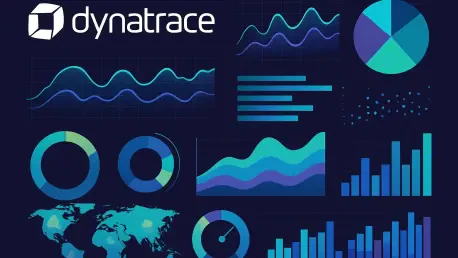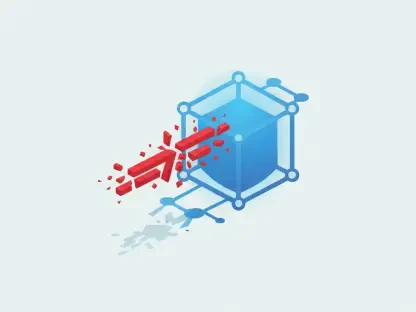In today’s fast-paced digital landscape, organizations are grappling with an overwhelming volume of data from diverse sources like applications, infrastructure, and AI-driven workloads, making it increasingly challenging to extract meaningful insights quickly. The ability to transform raw telemetry data into actionable intelligence is no longer a luxury but a necessity for maintaining performance, ensuring reliability, and controlling costs. Dynatrace Dashboards have been crafted with this precise goal in mind, redefining how teams interact with observability data through speed, clarity, and collaboration. This powerful app empowers users to explore, visualize, and act on data with intuitive tools like natural language queries and advanced visualizations. Whether the focus is on monitoring complex AI models or traditional IT environments, this solution adapts seamlessly to varied needs, turning data into real-time insights. To illustrate the transformative potential, consider a practical example of monitoring OpenAI APIs in a production setting, showcasing how these dashboards can address real-world challenges effectively.
1. Setting the Scene: Monitoring OpenAI APIs in Production
Imagine a SaaS company’s platform team that has recently integrated OpenAI capabilities to enhance features such as smart search, summarization tools, and interactive chatbots for an improved user experience. With these advanced features now live, the team faces the critical task of ensuring consistent performance, efficient scalability, and adherence to budget constraints. Dynatrace steps in as a vital ally, converting complex telemetry data into clear, actionable insights that enable proactive management of these AI-driven services. The focus is on creating a tailored dashboard to monitor key aspects of OpenAI LLM APIs, addressing specific metrics and potential pain points.
This process involves several targeted objectives to ensure comprehensive oversight. Teams aim to locate and integrate relevant OpenAI telemetry data effortlessly, customize visualizations to track token usage, latency, and error rates, and filter data by specific dimensions like model type or environment for focused analysis. Additionally, there is a strong emphasis on anticipating and preventing issues such as response slowdowns or unexpected cost spikes, which could impact user satisfaction or financial planning. By leveraging Dynatrace Dashboards, the platform team can address these challenges systematically, ensuring robust performance and cost efficiency.
2. Discovering and Incorporating Data Seamlessly
Creating an effective dashboard begins with identifying the most relevant data for a specific use case, particularly when monitoring LLM APIs where metrics like request volume, latency, and error rates are paramount. Dynatrace Dashboards simplify this process by offering intuitive tools for data exploration and analysis. Teams can start with pre-built dashboards for instant insights, navigate data through a user-friendly point-and-click interface to add tiles swiftly, or harness the advanced capabilities of Grail by crafting custom DQL queries. For added convenience, Davis CoPilot® transforms natural language prompts into precise queries, streamlining the journey from question to insight.
Beyond these initial options, the platform supports contextual data exploration through integrated apps such as Kubernetes, Logs, and Distributed Traces, allowing users to enrich dashboards with diverse perspectives. This flexibility ensures that regardless of technical expertise, teams can access and visualize the exact data needed for their monitoring goals. The seamless integration of these tools means that even complex datasets can be managed efficiently, providing a solid foundation for building dashboards that deliver real value in monitoring AI workloads or other critical systems.
3. Starting with Pre-Configured Dashboards for Immediate Impact
There’s no need to build from the ground up when Dynatrace provides a range of ready-made dashboards tailored for specific use cases, including AI and LLM stacks like OpenAI. These pre-configured options deliver immediate insights into critical metrics such as performance, request volume, latency, cost, and overall service health. By offering a starting point that already addresses common monitoring needs, these dashboards save significant time and effort, allowing teams to focus on customization rather than initial setup.
To begin, users can access the OpenAI-specific pre-built dashboard within the Dynatrace Playground and create a duplicate for personalization. This approach not only provides a quick entry into monitoring but also ensures that the foundation is robust, built on best practices for observability. From there, teams can adapt the dashboard to reflect unique requirements, adding or modifying elements to align with specific operational goals or to address particular challenges in their environment, ensuring relevance and effectiveness.
4. Enhancing Insights with Tiles for Token Usage Analysis
A critical step in monitoring OpenAI services involves visualizing prompt token usage, distinguishing between input and output types to understand consumption patterns. Dynatrace Dashboards facilitate this by allowing users to add a metrics tile and search for relevant data, such as custom metrics prefixed with “gen_ai” sent via OpenTelemetry. With just a few clicks, teams can apply data splits and aggregations to create insightful visualizations, ensuring that key trends are immediately apparent and actionable.
The resulting visualizations might include a pie chart to illustrate the balance between input and output tokens, alongside a line chart to track usage evolution over time. These tools transform raw telemetry into clear insights, enabling teams to monitor resource allocation and identify potential inefficiencies. Such detailed analysis is essential for maintaining cost control and optimizing the performance of AI-driven features, ensuring that resources are utilized effectively without unnecessary expenditure or bottlenecks impacting service delivery.
5. Leveraging Advanced Querying with Dynatrace Grail
For those unsure of where to begin or which metrics to prioritize, Dynatrace Grail offers a powerful solution through its integration with Davis CoPilot®. Embedded directly into Dashboards and Notebooks, this feature allows users to interact with data using plain language prompts, eliminating the need to manually write complex DQL queries or know exact metric names. A simple request like “Visualize token usage by input and output types” can instantly generate the appropriate query, delivering insights in seconds.
This capability significantly lowers the barrier to advanced data analysis, making it accessible to a broader range of team members regardless of their technical background. By simplifying the process of querying and visualizing data, Dynatrace ensures that teams can focus on interpreting results and making informed decisions rather than getting bogged down in technical complexities. The result is a faster, more efficient workflow that accelerates the path from data to action, enhancing overall monitoring effectiveness.
6. Customizing Visualizations for Clarity and Impact
When monitoring systems or ensuring service reliability, having the right insights at a glance is crucial, and Dynatrace Dashboards excel in delivering intuitive, impactful visualizations. The platform automatically suggests the most suitable visualization types based on the data context—for instance, recommending a line chart to highlight trends in API token usage over time. Additionally, smart defaults like sparklines for trend display and an enhanced search functionality speed up the configuration process for power users.
Further enhancements include updated features for pre-existing visualizations, such as the single value tile, which now supports icons, color thresholds for anomaly detection, and trend labels for added context. For geographic data, map components offer rich customization options like color rules and pin shapes, enabling location-based pattern analysis. These advancements ensure that dashboards are not only visually clear but also highly functional, allowing teams to quickly interpret data and take necessary actions to maintain performance and reliability.
7. Focusing on Critical Data through Filters and Segmentations
To transform a dashboard into a truly actionable tool, incorporating filters and segmentations is essential for creating dynamic views tailored to different audiences, environments, or services. Dynatrace enables this through powerful filtering capabilities, such as multidimensional global filters applied via reusable segments for contexts like environment or team, and dashboard-specific variables for fine-grained control over individual tiles, such as filtering by LLM model type.
This flexibility allows a single dashboard to serve multiple purposes, adapting to the specific needs of various stakeholders without requiring multiple versions. For instance, filtering an OpenAI dashboard by environment (production, staging, test) or model type ensures that the most relevant data is always in focus. Such targeted analysis helps teams drill down into specific issues or performance metrics, making it easier to address challenges and optimize operations in a way that aligns with organizational priorities.
8. Proactively Addressing Issues to Prevent Slowdowns and Costs
Dashboards are not just for passive observation; Dynatrace elevates them into proactive tools with AI-powered features that enable teams to act on data directly. Setting up alerts from charts is straightforward, allowing notifications for issues like response time thresholds that could affect user experience. This ensures that potential problems are identified and addressed before they escalate, maintaining service quality and user satisfaction.
Additionally, cost forecasting capabilities project future spending based on historical usage patterns, helping teams anticipate budget overruns and adjust resource allocation accordingly. By identifying high-cost contributors, such as the most expensive prompts, dashboards support optimization efforts and chargeback models. This proactive approach to monitoring bridges the gap between observation and action, empowering teams to make informed decisions that prevent slowdowns and control expenses effectively, ensuring operational efficiency.
9. Enabling Secure and Flexible Collaboration Across Teams
Effective monitoring often requires collaboration across different roles and departments, and Dynatrace Dashboards support this with robust sharing options. Teams can assign view or edit permissions to specific users or groups, roll out dashboards to all users within an environment, or generate links for broad internal visibility among authenticated users without managing individual access. These features ensure that the right people have access to the right data at the right time.
Such fine-grained control over collaboration fosters alignment and enhances decision-making by making critical insights accessible to relevant stakeholders. Whether it’s a platform team monitoring performance or a finance team tracking costs, shared dashboards create a unified view of data, breaking down silos and promoting a cohesive approach to problem-solving. This secure, flexible sharing mechanism is a cornerstone of effective observability, ensuring that insights drive collective action across the organization.
10. Reflecting on Transformative Monitoring Capabilities
Looking back, Dynatrace Dashboards redefined how teams engaged with observability data, offering a powerful means to monitor complex systems like LLM APIs or optimize cloud expenditures. The intuitive exploration of data, coupled with insightful visualizations featuring smart defaults and rich customization, provided clarity where complexity once reigned. Dynamic segmentation and filtering allowed tailored views for diverse use cases, while proactive features like forecasting and contextual alerts empowered teams to stay ahead of issues.
The impact of these capabilities was evident in the enhanced ability to turn raw telemetry into actionable intelligence. As a next step, exploring the Dynatrace Playground to browse ready-made dashboards or create customized ones using the steps outlined proved to be a valuable endeavor. This hands-on approach ensured that the full potential of the platform was realized, paving the way for continued improvements in monitoring and management practices across varied technological landscapes.









